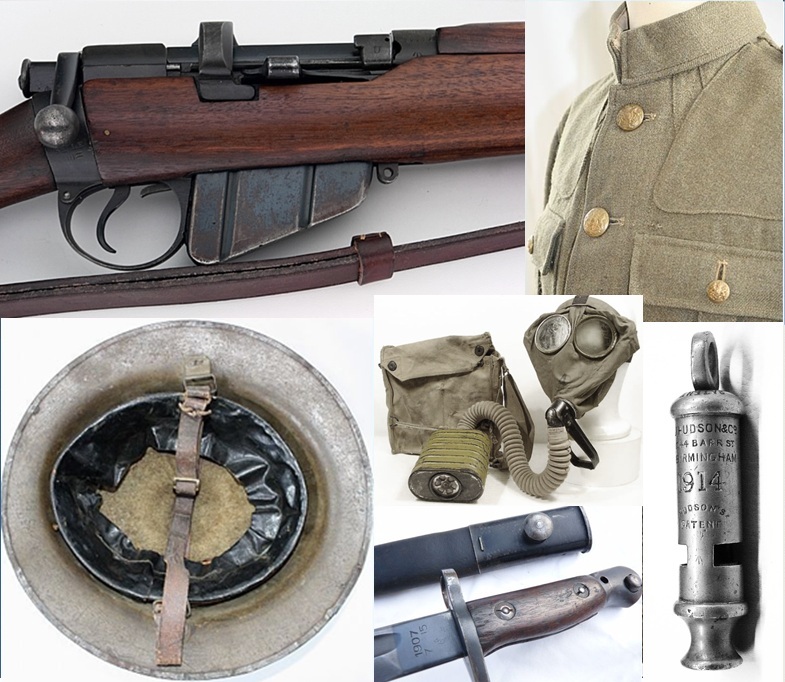The Great War was the first with campaigns fought by British troops on three continents – Europe, Asia and Africa. For the most part, the Western Front in Europe was to demand the most resources – men, equipment and supplies. The front became an incredible continuous line of trenches stretching from Switzerland to the North Sea. For the Tommy fighting the war, distant from the comfortable war rooms in which the campaigns were planned and managed, their world consisted of 6 foot deep mud trenches, looking up at patches of sky and waiting for their turn to ‘go over the top’ into enemy fire. And accompanying them in their everyday lives were their personal effects and equipment, items that can be collected today.
Today these everyday objects and equipment help describe the life of the ‘Poor Bloody Infantry’ in those trenches. The last Tommy from WW1, Harry Patch died in July, 2009 at the age of 111 years but through the objects as well as the writings and other relics remaining from that time, their stories live on.
Here are our top picks of WW1 items that illustrate the average life of the British Soldier during the Great War:
Small box respirator Gas Mask
The result of a number of developments, the British Small Box Respirator is both an icon of the Great War when poison gas attacks were first used against armies, but also recognisable as the forerunner to the modern gas mask. The Small Box Respirator was first introduced to British soldiers in April 1916 – a few months before the Battle of the Somme. By January 1917, it had become the standard issue gas mask for all British soldiers. Very collectable and difficult to find good examples.
Steel ‘Brodie’ helmet
In 1915 the British army decided it needed helmets to protect against shrapnel on the Western Front. The first regulation helmets were delivered in late 1915 designated “Brodies Steel Helmet War Office Pattern” Designed by John leopoled Brodie, and similar to the Medieval Kettle Hat which had a rimless design. The Type A was in production for just a few weeks before the specification was changed and the Type B introduced with a harder steel. Paint schemes were a mottled light green, blue, and orange camouflage, but they were also painted in green or blue-grey. The later 1916 Mk1 pattern added a rim and new pattern liner and Chin strap. Increasingly hard to find original examples of these early helmets, and prices are rising.
1902 Pattern (other ranks) Service Dress Tunic
The Tommy went to war wearing the 1902 Pattern Service Dress tunic. This was a thick woollen garment, dyed khaki. There were two breast pockets for personal items and the soldiers AB64 Pay Book, two smaller pockets for other items, and an internal pocket sewn under the right flap of the lower tunic where the First Field Dressing was kept. Rifle patches were sewn above the breast pockets, to prevent wear from the webbing equipment and rifle. Getting harder to find as time marches on and as surviving examples deteriorate. 1902 pattern tunics in good condition are highly prized by collectors.
Signalling whistle
The firm of Hudsons in Birmingham, manufacturers of Police whistles, supplied the iconic whistles blown to signify a gas attack or for Tommy to go ‘over the top’. Great War whistles are typically stamped with the date and the makers name, making identifying them straight forward. Relatively common to find these on the market, and usually affordable.
Pattern 1907 (P07) ‘Sword’ bayonet
The Pattern 1907 bayonet is widely recognized as the bayonet used with the Lee-Enfield .303 Tommy rifle, and an icon of the Great War. From opening a can of food to close quarters combat, the bayonet was a valuable tool for the Tommy in everyday life in the trenches. Helpfully most bayonets carry makers marks and dates to help identify a Great War era example from a later version. Collectable and a good buy for any WW1 enthusiast.
Lee-Enfield Mk. III .303 SMLE rifle
First appearing in 1907, the iconic Lee Enfield rifle was the standard issue rifle for the Tommy during the Great War – it was his companion in the trenches whilst he ate and slept, and his trusted weapon during the fighting. The SMLE Mk III model excelled in its role, though wartime demands for simpler and lower cost production forced a design change resulting in the Mk. III* design. The rifle had an effective range of 2,000 yards and was fed from a 10-round magazine loaded with 5-round charger clips through the top of the weapon. A must for the Great War collector, prices are strong for good deactivated examples.
So now you know our top picks of Great War Tommy Militaria, where do you go next to advance your own Great War militaria collection? Our Buy pages of course >>
Many thanks to WARSTUFF.com
